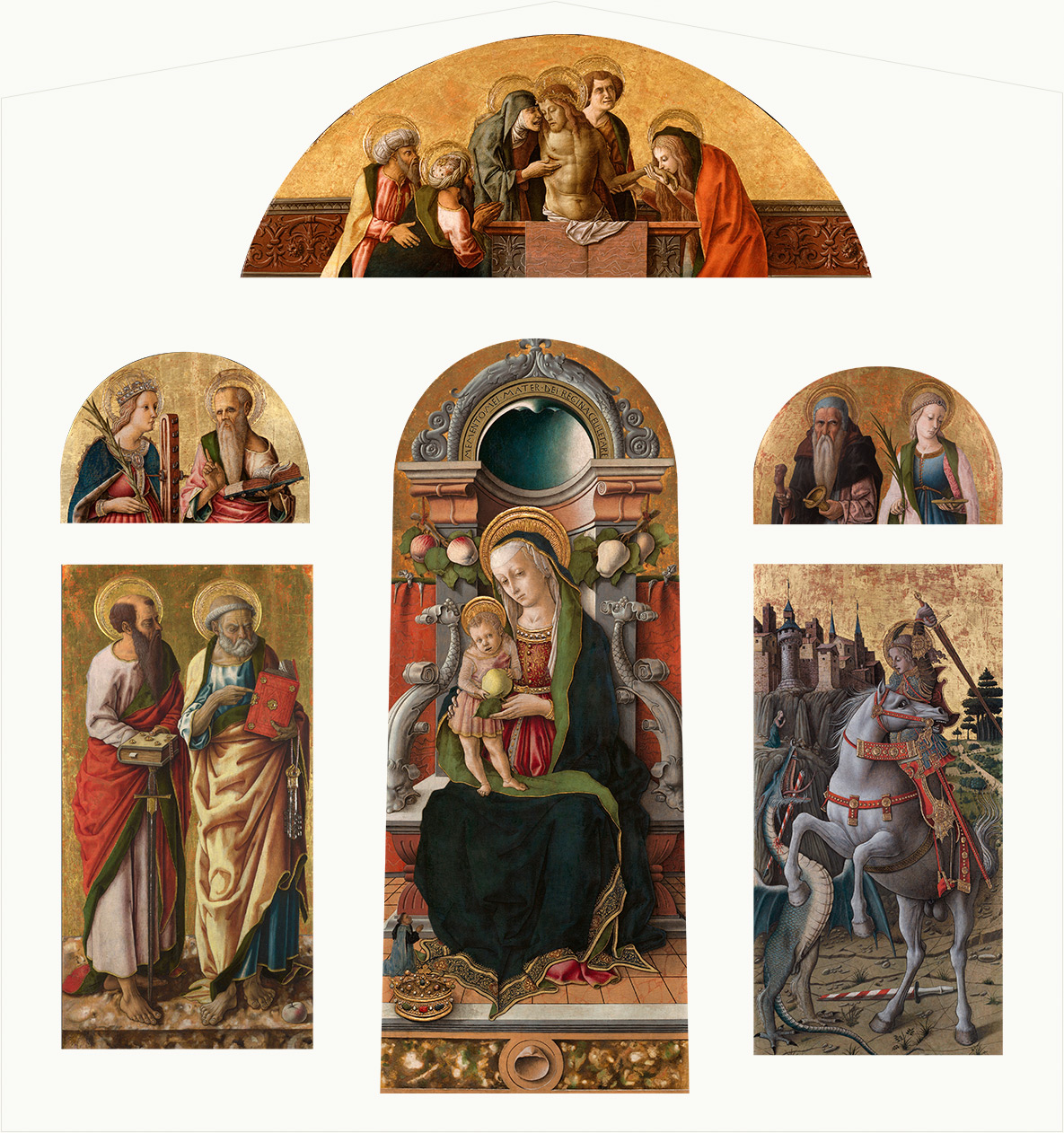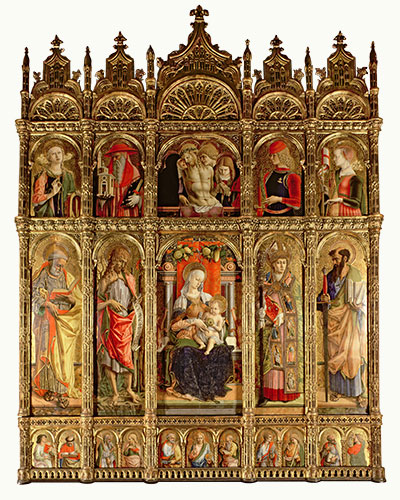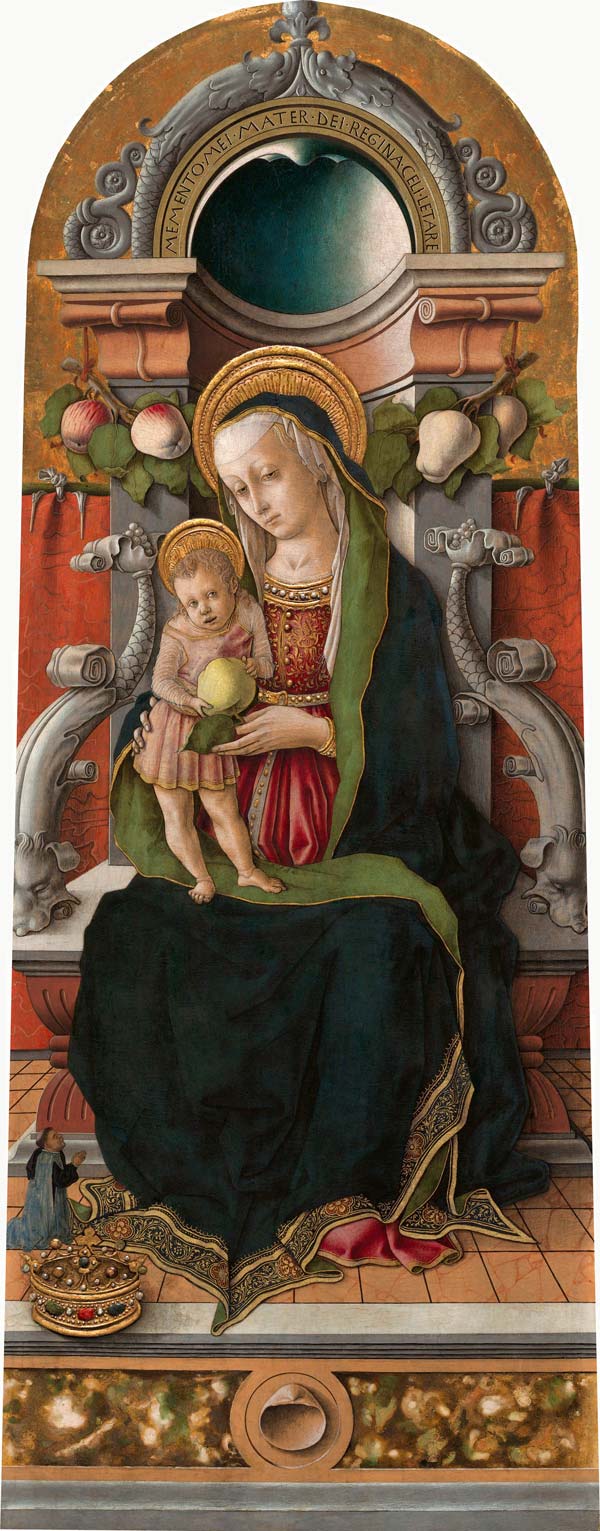
An Altarpiece Reunited
Explore Crivelli's Porto San Giorgio altarpiece, digitally reassembled as it might once have appeared.

Monumental altarpieces with multiple images (polyptychs) were a staple of Crivelli’s painting practice. All the paintings above were part of a single polyptych. Finished in 1470, the Porto San Giorgio altarpiece stood over the high altar of the parish church in this Adriatic coastal town and remained within its walls for over four hundred years. Following the demolition of the church in 1803, the altarpiece was sawn apart and its paintings dispersed to collections in Europe and the United States. Isabella Stewart Gardner purchased Saint George in 1897, bringing the first Crivelli to America. The six surviving panels are assembled in this virtual reconstruction, evoking the splendor of Crivelli’s early masterpiece.
Curator Nathaniel Silver on how the altarpiece might have looked (transcript)


The Lamentation
1470 On panel Detroit Institute of Arts, DetroitPorto San Giorgio Altarpiece
Wailing in anguish, the Virgin entombs her son. Slumped under the weight of Christ’s body, Mary Magdalene and John the Evangelist assist the Virgin, tears running down their cheeks. Joseph of Arimathea and Nicodemus kneel in prayer before Christ, his body bearing the wounds from the Crucifixion. His crown of thorns projects from the painted surface in high relief. Crivelli transformed this traditional symbol of Christ’s agony into virtuoso ornament, transcending the boundaries of painted illusion and investing it with presence. He deployed a similar technique for Saint Catherine’s crown.
Photo: Bridgeman Images.

Saints Catherine of Alexandria and Jerome (?)
1470 On panel Philbrook Art Center, Tulsa, Gift of the Samuel H. Kress FoundationPorto San Giorgio Altarpiece
Daughter of a king and dressed accordingly, Catherine cuts a regal figure. Her crown and bejeweled clasp stand out in relief. Crivelli sculpted her accessories from gesso (pastiglia), gilded them with gold leaf, and then painted the gems to evoke rubies and pearls. Such tangible luxuries contrast with a ferociously spiked wheel. Catherine destroyed the instrument of her suffering with the power of prayer, transforming it into an emblem of her unshakable faith. Crivelli called attention to the wheel with impressive foreshortening.
© 2015 Philbrook Museum of Art, Inc., Tulsa, Oklahoma.

Saints Paul and Peter
Not in exhibition 1470 On panel The National Gallery, LondonPorto San Giorgio Altarpiece
First preacher and first pope, Paul and Peter are fundamental figures in the history of Christianity. Crivelli envisioned these spry old men as if engaged in conversation. Peter directs Paul’s attention to a passage of his open book. Below, the keys to heaven – shaped in pastiglia and covered with silver and gold – hang lightly from Peter’s wrist.
Photo: © National Gallery, London / Art Resource, NY.

The Virgin and Child Enthroned with a Donor
1470 On panel National Gallery of Art, Washington, Samuel H. Kress CollectionPorto San Giorgio Altarpiece
Inscribed: MEMENTO MEI MATER DEI REGINA CELI LETARE (Remember me, O Mother of God, O Queen of Heaven rejoice)
The enthroned Virgin Mary tenderly embraces her son. Christ clasps the apple, a symbol of the Fall and man’s redemption. The garland above them celebrates the newborn Redeemer and honors the Queen of Heaven. To frame the Virgin’s monumental figure, Crivelli painted a spectacular marble throne and inscribed it with a prayer invoking her intercession on the donor’s behalf. This unidentified cleric kneels in devotion, mouth open, as if in perpetual petition to the Virgin.
A gilded crown sparkles at the Virgin’s feet. Embossed on the flat surface in gesso relief (pastiglia), it recalls the kind of offerings of gratitude that worshippers brought to the Virgin at nearby shrines like Loreto. Situated on a ledge between Virgin and viewer, Crivelli’s crown casts a shadow. At once an actual tribute and a carefully conjured illusion, it invokes the power of material homage as the conduit to divine favor.
Photo Courtesy National Gallery of Art, Washington.

Saints Anthony Abbot and Lucy
Not in exhibition 1470 On panel National Museum, Krakow, Collections of the Princes Czartoryski FoundationPorto San Giorgio Altarpiece
The founder of Christian monasticism, Anthony Abbot sought divine truth in the deserts of northern Egypt. In contrast with Lucy’s crystalline complexion, his sunbaked skin and long beard attest to the ascetic life of this early Christian hermit. Anthony wears the black habit, or uniform, of a Hospitaller brother. These laymen established hospitals in this saint’s name across Europe for victims of a painful disease called ergotism (known to Crivelli’s contemporaries as Saint Anthony’s Fire). To ward off the deadly illness, they carried charms carved from the root of the mandrake plant. Crivelli recalled one of the mandrake charms in the miniature head of Anthony’s wooden staff.

Saint George Slaying the Dragon
1470 Tempera, gold and silver on panel Isabella Stewart Gardner Museum, BostonPorto San Giorgio Altarpiece
Crivelli compressed the story of Saint George – who saved a city and its princess from the marauding dragon – into a single, dynamic moment. Run through with a lance, the monster roars in agony, frightening this saint’s steed. The horse rears up and shies away, eyes wide with fear. In a feat of remarkable horsemanship, George stands, drops the reins and draws his sword to deliver the death blow. A rare subject for the side panel of an altarpiece, this image constituted the right side of the Porto San Giorgio polyptych.
Learn more about the Gardner's conservation of this work in Beneath the Surface.
